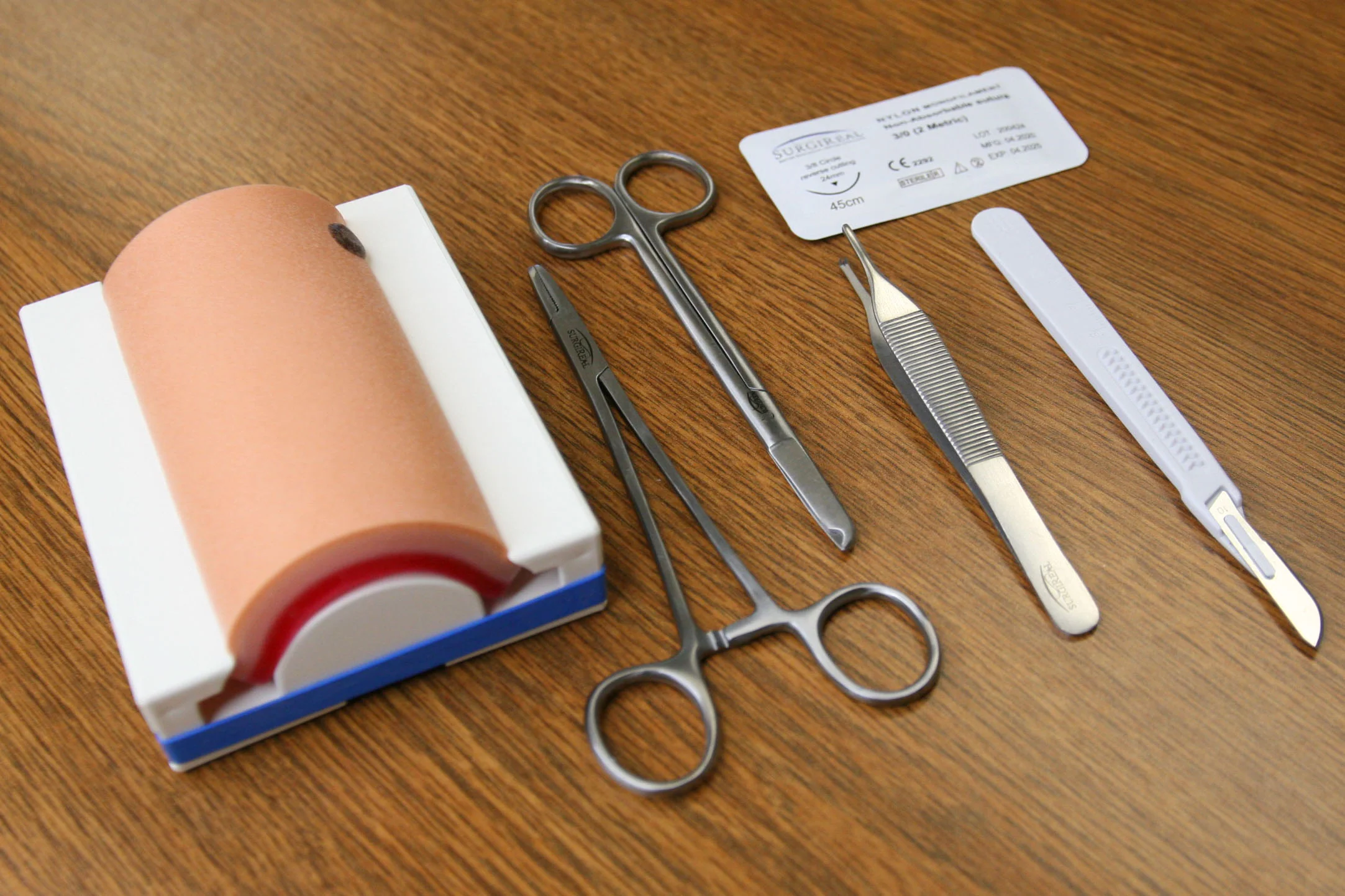Surgical training is one of the most demanding and rigorous aspects of medical education. Surgeons must develop not only a deep understanding of anatomy and pathology but also the precise technical skills required to perform surgeries safely and effectively. One of the key components of this technical training involves mastering suturing and stapling techniques. Realistic suture and staple pads have become essential tools in this training process, providing medical students and surgical residents with a safe, controlled environment to practice these critical skills. In this blog post, we explore the importance of realistic suture and staple pads in surgical training, highlighting benefits that extend beyond traditional learning methods.
1. Developing precision and dexterity
Why precision matters in surgery:
Suturing and stapling are fundamental techniques used in almost every type of surgery, from minor procedures to major operations. The precision and dexterity required for these tasks cannot be overstated. A single poorly placed stitch or staple can lead to complications such as infection, dehiscence (wound reopening), or poor cosmetic outcomes. Realistic suture and staple pads provide an ideal platform for developing the fine motor skills and hand-eye coordination that are crucial for successful surgery.
Key benefits:
Tactile feedback: high-quality suture and staple pads are designed to mimic the texture and resistance of human skin and tissues, providing realistic tactile feedback. This helps trainees develop the feel for how much tension to apply and how deeply to insert needles or staples.
Repetition and muscle memory: repeated practice on suture pads allows trainees to build muscle memory, making their movements more precise and automatic over time. This is particularly important for developing the speed and efficiency needed in an operating room setting.
Safe practice environment: suture and staple pads offer a safe environment where students can practice without the pressure of working on a live patient. This reduces the risk of errors and allows for experimentation with different techniques.
Less discussed aspect: the role of suture and staple pads in teaching the importance of consistent technique is often overlooked. Consistency is key in surgery, and these pads allow trainees to practice producing evenly spaced, uniform sutures or staples, which is crucial for wound healing and minimizing scarring.
Stat to know: according to a study published in the journal of surgical education, trainees who practiced on realistic suture pads showed a 45% improvement in their suturing speed and accuracy compared to those who only received traditional instruction.
2. Building confidence before clinical practice
Why confidence is critical in surgery:
Confidence is a significant factor in surgical performance. A surgeon who is confident in their skills is more likely to perform procedures efficiently and make decisive actions when needed. For students and residents, realistic suture and staple pads provide the opportunity to build this confidence before they ever step into an operating room.
Key benefits:
Hands-on experience: suture and staple pads provide realistic scenarios where trainees can apply their knowledge and skills, helping them transition from theoretical learning to practical application.
Error management: practicing on pads allows trainees to make and correct mistakes without the risk of harming a patient. This trial-and-error process is crucial for learning how to handle unexpected challenges during surgery.
Progressive skill development: trainees can start with basic suturing and stapling techniques and gradually progress to more complex scenarios as they build their confidence. This stepwise approach helps ensure that they are fully prepared for the complexities of real surgeries.
Less discussed aspect: the importance of reducing anxiety through repeated practice is often overlooked. Many surgical trainees experience anxiety when performing procedures for the first time on live patients. Realistic suture and staple pads help reduce this anxiety by allowing trainees to practice until they feel confident in their abilities.
Stat to know: a survey conducted by the american college of surgeons found that 83% of surgical residents reported increased confidence in their suturing and stapling skills after extensive practice on realistic simulation pads, highlighting the value of these tools in surgical training.
3. Enhancing surgical technique and safety
Why technique and safety are paramount:
Surgical technique directly impacts patient outcomes. Poor technique can lead to complications, prolonged recovery times, and even the need for additional surgeries. Realistic suture and staple pads allow trainees to refine their techniques in a controlled environment, ensuring that they develop the skills necessary to perform surgeries safely and effectively.
Key benefits:
Technique refinement: trainees can practice different suturing and stapling techniques, such as interrupted, continuous, or subcuticular sutures, and receive immediate feedback on their performance. This helps them understand the advantages and limitations of each technique.
Error reduction: by practicing on realistic pads, trainees learn how to avoid common mistakes, such as placing sutures too tightly (which can cause tissue necrosis) or too loosely (which can lead to wound dehiscence). This practice helps reduce the risk of errors during actual surgeries.
Adapting to different tissue types: realistic suture pads can be designed to mimic different types of tissues, such as skin, muscle, or fascia. This allows trainees to practice adapting their techniques to the specific requirements of different tissue types, improving their versatility as surgeons.
Less discussed aspect: the role of suture and staple pads in teaching wound tension management is often overlooked. Proper management of wound tension is critical for ensuring that the wound edges align correctly and that the patient heals with minimal scarring. Simulation pads allow trainees to practice achieving the right balance of tension.
Stat to know: research in the journal of surgical research found that surgeons who had extensive practice on suture and staple pads were 35% less likely to make critical technical errors during surgery, underscoring the importance of these training tools in enhancing surgical safety.
4. Bridging the gap between classroom learning and real surgery
Why bridging the gap is important:
Medical students and surgical residents spend a significant amount of time learning the theory behind surgical procedures. However, there is often a gap between this theoretical knowledge and the practical skills required in the operating room. Realistic suture and staple pads help bridge this gap, providing a hands-on way to apply classroom learning in a realistic context.
Key benefits:
Application of theoretical knowledge: suture and staple pads allow trainees to apply their knowledge of anatomy, wound healing, and surgical principles in a practical setting. This reinforces their understanding and helps them see how theoretical concepts translate into surgical practice.
Interactive learning: unlike traditional lectures or textbooks, suture and staple pads offer an interactive learning experience. Trainees can actively engage with the material, which enhances retention and deepens their understanding of surgical techniques.
Preparation for clinical rotations: practicing on suture and staple pads prepares trainees for their clinical rotations by giving them the opportunity to develop and refine their skills in a low-stress environment. This preparation is crucial for ensuring that they are ready to perform procedures on real patients.
Less discussed aspect: the use of suture and staple pads in conjunction with other simulation tools, such as virtual reality (vr) or augmented reality (ar) systems, is an emerging trend that offers a more immersive learning experience. This combination allows trainees to practice suturing and stapling within the context of a full surgical procedure, enhancing their readiness for real surgeries.
Stat to know: a study published in the annals of surgery found that medical students who used suture and staple pads in their training were 50% more likely to successfully perform basic surgical procedures during their clinical rotations, compared to those who did not use these tools.
5. Supporting lifelong learning and skill maintenance
Why lifelong learning is crucial:
Surgical skills require continuous refinement and practice, even after a surgeon has completed their formal training. Realistic suture and staple pads are not only valuable for trainees but also for practicing surgeons who wish to maintain their skills, learn new techniques, or prepare for particularly challenging cases.
Key benefits:
Skill maintenance: practicing on suture and staple pads allows surgeons to maintain their dexterity and technique, ensuring that their skills remain sharp throughout their careers.
Learning new techniques: surgeons can use these pads to learn and perfect new suturing or stapling techniques before applying them in the operating room. This is particularly important as new surgical methods and technologies emerge.
Preparation for complex cases: for particularly challenging surgeries, experienced surgeons can use suture and staple pads to rehearse specific techniques or procedures, helping them prepare for the nuances of the case and reducing the likelihood of intraoperative complications.
Less discussed aspect: the potential for suture and staple pads to be used in team training exercises is often overlooked. Surgical procedures require seamless collaboration between the surgeon and the surgical team. These pads can be used in team-based simulations to improve communication, coordination, and efficiency in the operating room.
Stat to know: according to the american journal of surgery, surgeons who regularly practiced on simulation pads were 40% more likely to report feeling confident in their ability to learn and apply new surgical techniques, emphasizing the importance of these tools in supporting lifelong learning .
Conclusion: the essential role of realistic suture and staple pads in surgical training
Realistic suture and staple pads are invaluable tools in surgical training, providing a safe and effective way for medical students, residents, and even experienced surgeons to develop and refine their skills. By offering tactile feedback, enabling repetitive practice, and bridging the gap between theory and practice, these simulation tools play a crucial role in preparing healthcare professionals for the demands of the operating room.
As surgical techniques continue to evolve and the expectations for patient safety and outcomes grow, the importance of high-quality training tools like suture and staple pads cannot be overstated. By incorporating these tools into surgical education, medical institutions can ensure that their trainees are well-equipped to deliver the highest standard of care.




